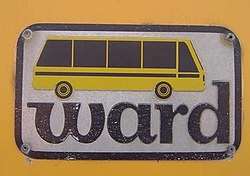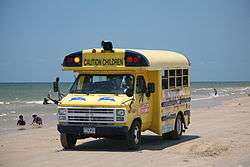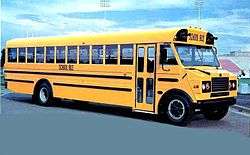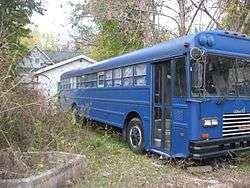Ward Body Works
Ward Body Works (also known as Ward Industries and Ward School Bus Manufacturing, Inc.) was a defunct American bus manufacturer. Headquartered in Conway, Arkansas, Ward specialized in yellow school buses, alongside buses for other uses. Founded in 1933 by D.H. "Dave" Ward, the company was family-owned for nearly its entire existence.
 | |
| Family-owned | |
| Industry | Transportation |
| Fate | Chapter 11 Bankruptcy Re-organized as American Transportation Corporation |
| Successor | American Transportation Corporation (AmTran) |
| Founded | 1933 |
| Founder | D.H. Ward |
| Defunct | 1980, (company) 1992, (brand by successor AmTran from 1980-1992) |
| Headquarters | Conway, Arkansas |
Number of locations | 2 (Conway, Arkansas and Beaver Falls, Pennsylvania) |
Area served | North America |
| Products | School Buses Commercial Buses |
Among several innovations, Ward was the first manufacturer to perform a rollover test on a school bus, leading to changes in school bus body design.[1] Ward would also become the first school bus manufacturer to assemble buses on an assembly line.[2]
In 1980, Ward filed for bankruptcy and was reorganized as American Transportation Corporation (AmTran) keeping the Ward brand name in use on school buses. In 1991, AmTran was acquired by Navistar International, with the Ward name phased out during 1992. Today, International produces school buses using its IC Bus subsidiary (the successor to AmTran).
History
D. H. "Dave" Ward founded Ward Body Works in Conway, Arkansas, in 1933 when he "lowered the roof of a wooden bus for Mr. Carl Brady of the Southside Schools". Southside Schools were located about 15 miles north of Conway.[3] A blacksmith by trade, Ward grew his business primarily on body repair of bus bodies in the area.[4] In 1936, he built his first complete school bus body. One of the first manufacturers of the time to use all-metal construction, the first school bus made by Ward Body Works featured removable safety-glass windows and perimeter and center-mounted seating.[4]
In 1939, the company opened a 10,000 square-foot factory in Conway, Arkansas.[4] During World War II, along with supplying buses for the military, Ward built over 1000 different bodies of various types for the GMC CCKW cargo truck.[4] Following the war, the company became one of the first bus manufacturers to expand outside of the United States, opening a facility in Mexico City in 1947; bus bodies from Conway would be shipped to Mexico to be placed on chassis for use internationally.[4] To expand capacity inside the United States, a second facility was opened in Austin, Texas in 1951.[4][5]
Despite expanding to 100,000 square feet, the original Ward factory in Conway was too small to keep up with demand; the company built an even larger factory outside of the city in 1954; at any given time, 45 bus bodies could be on the 1,500-foot-long assembly line, producing up to 100 complete buses weekly.[5] Later in the 1950s, the company moved beyond its school bus roots, adding mass-transit and sightseeing buses to its product lineup.[5] Due to importation issues, the Ward factory in Mexico was closed in 1954.
In 1956, Ward became both a body manufacturer and an industry supplier, as the company created a subsidiary, C.S. Sash Company, which became a major aluminum window frame manufacturer for school buses.[4][5]
In the 1960s, Ward School Bus Manufacturing, Inc. began a series of updates that would modernize manufacturing and production. To catalog the various state and local regulations affecting school bus specifications, in 1964, company owner Charles Ward set up a computer mainframe (using IBM 360s).[1] In the same year, Ward performed the first independent rollover test on a school bus, discovering issues related to structural integrity.[2] During 1967, the assembly line in the Conway facility was upgraded to a moving assembly line, a first in the bus industry.[2] In 1969, the recommendations from the crash test were published, finding that an inconsistent number of fasteners among manufacturers could lead to poor joint strength.[1] The findings would be used in part to government recommendations for school bus joint strength.[2] Following the 1968 retirement of Dave Ward, Ward Body Works remained a family-owned company, with son Charles Ward handling operations.
During the 1970s, Ward would become one of the largest school bus body manufacturers in the United States, with the company holding a 25% market share in 1973.[6] In 1970, the Austin plant was replaced by an all-new facility in Beaver Falls, Pennsylvania. To expand into small buses, Ward purchased Texas-based manufacturer Coachette in 1973, moving their production into a separate facility in Conway.[5] Additionally, the assembly line at the main Conway facility was upgraded and connected to an IBM 370 mainframe, as the company explored computer-based manufacturing.[2] Coinciding with the new assembly line was the redesigned full-size conventional bus body, dubbed the Ward Volunteer. Aside from a redesigned windshield and the change in chassis suppliers, the Ward Volunteer shares many components with that of the IC Bus CE-Series produced today.
Along with other school bus manufacturers, the late 1970s would prove to be a rough time for Ward, which had been renamed Ward School Bus Manufacturing, Inc. In 1975, the Pennsylvania plant was forced to close. A year later, Ward would produce a prototype for the first front-wheel drive full-size school bus, but the company was forced to abandon the project before it reached production. As Ward faced declining demand for school buses, the company was over $20 million in debt; in July 1980, the company filed for Chapter 11 bankruptcy.
In August 1980, an investment group assisted by the then-Arkansas Governor Bill Clinton purchased the assets of Ward Industries. While the school buses would still bear the Ward name, the only interests that the Ward family would keep in the new company would be in vehicle distribution. By 1981, Ward was officially known as AmTran (American Transportation Corporation).
Products
| Model Name | Production | Configuration | Chassis Supplier | Notes |
|---|---|---|---|---|
| Vanguard
|
1985-1992 | Type A (Cutaway van)
dual rear wheel |
Chevrolet G30/GMC Vandura | The Vanguard was the first cutaway-body school bus designed with 5 rows of passenger seating.[1] |
| Coachette | Type B (Integrated)
stripped chassis |
Chevrolet P30 | ||
| Patriot
|
1985-1991 | Type C (Conventional; semi-forward control)
stripped chassis |
General Motors (Chevrolet/GMC B-Series) | The Patriot was the first semi-forward control conventional, combining the sloped nose of a Type B bus with a full-size body. It was based on a modified version of the GM conventional chassis.[1] |
| Volunteer
|
1973-1992 | Type C (Conventional) | Dodge D-300 (1973-1977)
Chevrolet/GMC B-Series Ford B-600/B-700/B-800/B-8000 International Harvester Loadstar 1703/1803 (1973-1978) International Harvester/Navistar S-1700/S-1800 (1979-1989) International 3700/3800 (mid 1989-1992) |
The Volunteer was an all-new body redesign introduced by Ward for 1973.
Minor updates were given in 1980, 1986, and 1988. Following the dissolution of the Ward brand, the Volunteer remained in production as an AmTran. |
| President
|
c.1973-1989 | Type D (Transit-style)
Front-engine |
International Harvester 1853FC
General Motors S-7 (Chevrolet/GMC) Asia-Smith Motors front-engine |
The President was the Ward counterpart of the Blue Bird All American and Thomas Saf-T-Liner. However, it was only built in a front-engine configuration.
In 1976, Ward built a prototype derived from body of the President. Using a modified IHC chassis, it was the first front-wheel drive school bus; it did not enter production. |
| Senator
|
1990-1992 | Type D (Transit-style)
Front-engine |
Navistar International FC3900 | Replacing the President, the Senator was the Ward counterpart of the Blue Bird TC/2000 and the Wayne Lifestar. Following the dissolution of the Ward brand, the Senator underwent minor revisions to become the AmTran Genesis. |
See also
| Wikimedia Commons has media related to AmTran/Ward buses. |
References
- "The History of School Transportation". Stnonline.com. Archived from the original on 2010-01-02. Retrieved 2016-03-09.
- "Ward Body Works". Frana Wiki. Retrieved 3 December 2014.
- Mosby, Joe (2009-11-06). "Ward had idea and ran with it | TheCabin.net - Conway, Arkansas". TheCabin.net. Retrieved 2016-03-09.
- "Ward Body Works, Ward School Bus Mfg., IC Bus, Ward School Bus history, David H. Ward, Dave Ward, AmTran, Navistar, IC Corp., Conway, Arkansas - CoachBuilt.com". Coachbuilt.com. Retrieved 2015-10-10.
- "Dave Ward". Frana Wiki. Retrieved 3 December 2014.
- "IC Corporation aka: Inc. Ward Transportation Services". Encyclopedia of Arkansas History & Culture. Retrieved 3 December 2014.




